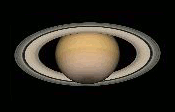SATURN
Physical Characteristics:
-
- Saturn is primarily composed of hydrogen and helium, similar to Jupiter.
- It has a diameter of about 116,464 kilometers (72,366 miles) and is known for its low density.
Ring System:
-
- Saturn's ring system is one of the most extensive and complex in the solar system.
- The rings are made up of numerous particles, ranging in size from tiny dust grains to larger boulders.
- The exact origin of the rings is not fully understood, but they are thought to be the remnants of moons, comets, or other objects that were shattered by tidal forces.
Moons:
-
- Saturn has a diverse array of moons, with over 80 confirmed natural satellites.
- The largest moon, Titan, is the second-largest natural satellite in the solar system, after Jupiter's Ganymede.
- Titan is unique among Saturn's moons because it has a thick atmosphere, and it has been studied extensively by spacecraft, including the Cassini-Huygens mission.
Exploration:
-
- The Cassini-Huygens spacecraft, a joint NASA-ESA-ASI mission, provided valuable data about Saturn and its moons. The Cassini orbiter studied the planet and its system for over 13 years, and the Huygens probe landed on Titan in 2005.
- Other missions, such as Voyager 1 and 2, also provided significant information about Saturn during their flybys in the early 1980s.
Ring Formation:
-
- Saturn's rings are composed primarily of ice particles, water ice, and rocky material.
- The exact origin of the rings is not definitively known, but they are believed to be remnants of moons, comets, or other objects that were shattered by tidal forces.
Ring Structure:
-
- Saturn's ring system is divided into several major ring groups, labeled alphabetically in the order of their discovery. The main rings are A, B, and C, with the Cassini Division separating the A and B rings.
- The rings are surprisingly thin, with a thickness that varies but is generally just tens of meters.
Ring Dynamics:
-
- The rings are not solid structures but consist of countless individual particles, ranging in size from tiny dust grains to larger chunks.
- The particles in the rings orbit Saturn independently and collectively create the appearance of a continuous, flat disk.
Tilt and Changing Perspective:
-
- Similar to Earth, Saturn has an axial tilt. Its axis of rotation is tilted by about 26.7 degrees.
- As Saturn orbits the Sun, the tilt of its rings becomes apparent from Earth, creating a dynamic and changing perspective for observers. This tilt gives rise to a nodding effect as seen from Earth.
Visibility from Earth:
-
- Saturn is visible to the naked eye from Earth, and its rings are a prominent feature even in small telescopes.
- The visibility of the rings changes over time due to their tilt, providing different views to observers on Earth.
Potential Future Changes:
-
- According to NASA, there is a possibility that Saturn might lose its rings over the next several hundred million years. The rings are gradually being pulled into the planet by its gravity, forming a dusty rain of ice particles under the influence of Saturn's magnetic field.
Exploration:
-
- Spacecraft like Voyager 1 and 2 provided valuable data on Saturn and its rings during their flybys in the early 1980s.
- The Cassini-Huygens mission, which concluded in 2017, provided an in-depth study of Saturn, its rings, and its moons.

- Similar to Earth's axial tilt of 23.5 degrees, Saturn's axis of rotation is inclined at an angle of 26.7 degrees. Notably, Saturn's extensive ring system is also tilted concerning the plane of its orbit around the Sun.
- Consequently, as Saturn completes its orbit, it appears to nod upward and downward when observed from Earth, resulting in a changing perspective of its rings.
- Saturn's orbital period around the Sun is 29.5 years, and every 13 to 15 years, there is an alignment where the edge of its rings directly lines up with Earth.
- Given the slim nature of the rings, typically just tens of meters thick in most areas, when they are in this specific position, they reflect minimal light, rendering them nearly invisible.
- This alignment phenomenon makes it challenging to observe the rings during these periods, as explained by Vahe Peroomian, a professor of physics and astronomy at the University of Southern California
5.Disappearance of rings in future
As per a 2018 publication from the National Aeronautics and Space Administration (NASA), there is a likelihood that Saturn will shed its rings entirely within the next 300 million years, possibly even sooner. The anticipated cause for this phenomenon is the gravitational pull of the planet, drawing the rings inward. This gravitational influence, combined with Saturn's magnetic field, is causing a gradual descent of the rings in the form of a dusty rain of ice particles, as detailed in the report.
Source: Indianexpress




